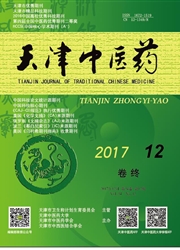

 中文摘要:
中文摘要:
[目的]探讨白芷总香豆素、川芎嗪及二者配伍应用对大鼠脑缺血/再灌注损伤的保护作用及机制。[方法]实验分为假手术组、缺血再灌注组、川芎嗪(7.5mg/kg)组、白芷总香豆素组(50mg/kg)、川芎嗪-白芷总香豆素(7.5mg/kg+50 mg/kg)组、尼莫地平(10 mg/kg)组。连续灌胃给药7 d后,采用线栓法建立大鼠大脑中动脉栓塞(MCAO)脑缺血/再灌注损伤模型。缺血2h再灌注22h后进行神经功能缺失症状评分,红四氮唑(TTC)染色法检测脑梗死体积,制备脑组织匀浆测定超氧化物歧化酶(SOD)活力和丙二醛(MDA)含量。[结果]与缺血再灌注组相比,川芎嗪、白芷总香豆素及配伍应用能明显改善大鼠受损的神经功能障碍(P〈0.05),提高SOD的活力(P〈0.01,P〈0.05,P〈0.01),降低MDA的含量(P〈0.01),川芎嗪-白芷总香豆素组显著缩小梗死体积(P〈0.05)。[结论]白芷总香豆素、川芎嗪及配伍使用对大鼠脑缺血/再灌注损伤都有明显保护作用,可能与抑制脑组织脂质过氧化反应相关。
 英文摘要:
英文摘要:
[Objective] To investigate the individual and compatible effects of coumarins extracts of Angelica dahurica and tetram- ethylpyrazine(TMP) on cerebral ischemia/reperfusion(I/R) injury in rats. [Methods] Male healthy SD rats were randomly divided into six groups: sham group, I/R group, TMP group (7.5 mg/kg tetramethylpyrazine), TCE group (50 mg/kg total coumarins extract of Angelica dahurica), TMP-TCE group (7.5 mg/kg+50 mg/kg) and Nimodipine group (10 mg/kg). Rats were pretreated with test drugs for sequential seven days by intragastric administration and underwent focal cerebral ishchemia for 2 h and reperfusion for 22 h. The neurofunctional scores were evaluated and the infarct volume was measured by triphenyltetrazolium chloride (TYC) staining. The activity of superoxide dismutase (SOD) and malondialdehyde (MDA) content in brain were determined to investigate the mechanism. [Results] Compared with I/R group, the neurological deficit in TMP, TCE and TMP-TCE group was significantly improved (P〈0.05), meanwhile the cerebral infarct volume of TMP-TCE group was reduced significantly (P〈0.05). The activity of SOD was enhanced (P〈0.05 or P〈0.01), and the content of MDA was decreased (P〈0.01). [Conclusion] Individual and compatible application of the total coumarins extract of Angelica dahurica and tetramethylpyrazine have a protective effect against the ischemic stroke, which might be related with inhibiting the lipid peroxidation of the brain tissue.
 同期刊论文项目
同期刊论文项目
 同项目期刊论文
同项目期刊论文
 期刊信息
期刊信息
